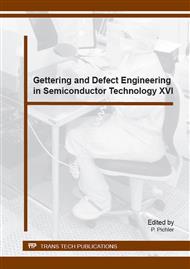[1]
A. Goodrich, P. Hacke, Q. Wang, B. Sopori, R. Margolis, T.L. James, et al., A wafer-based monocrystalline silicon photovoltaics road map: Utilizing known technology improvement opportunities for further reductions in manufacturing costs, Sol. Energy Mater. Sol. Cells. 114 (2013).
DOI: 10.1016/j.solmat.2013.01.030
Google Scholar
[2]
F. Granek, C. Reichel, Back-contact back-junction silicon solar cells under UV illumination, Sol. Energy Mater. Sol. Cells. 94 (2010) 1734–1740. doi: 10. 1016/j. solmat. 2010. 05. 038.
DOI: 10.1016/j.solmat.2010.05.038
Google Scholar
[3]
R.S. Bonilla, F. Woodcock, P.R. Wilshaw, Very low surface recombination velocity in n-type c-Si using extrinsic field effect passivation, J. Appl. Phys. 116 (2014) 054102.
DOI: 10.1063/1.4892099
Google Scholar
[4]
T.C. Kho, S.C. Baker-Finch, K.R. McIntosh, The study of thermal silicon dioxide electrets formed by corona discharge and rapid-thermal annealing, J. Appl. Phys. 109 (2011) 6.
DOI: 10.1063/1.3559260
Google Scholar
[5]
J. Schmidt, A.G. Aberle, Easy-to-use surface passivation technique for bulk carrier lifetime measurements on silicon wafers, Prog. Photovoltaics. 6 (1998) 259–263.
DOI: 10.1002/(sici)1099-159x(199807/08)6:4<259::aid-pip215>3.0.co;2-z
Google Scholar
[6]
R.S. Bonilla, P.R. Wilshaw, A technique for field effect surface passivation for silicon solar cells, Appl. Phys. Lett. 104 (2014) 232903. doi: 10. 1063/1. 4882161.
DOI: 10.1063/1.4882161
Google Scholar
[7]
R.A. Sinton, A. Cuevas, M. Stuckings, Quasi-steady-state photoconductance, a new method for solar cell material and device characterization, in: Photovolt. Spec. Conf. 1996., Conf. Rec. Twenty Fifth IEEE, 1996: p.457.
DOI: 10.1109/pvsc.1996.564042
Google Scholar
[8]
I.D. Baikie, S. Mackenzie, P.J.Z. Estrup, J.A. Meyer, Noise and the Kelvin method, Rev. Sci. Instrum. 62 (1991) 1326–1332. doi: 10. 1063/1. 1142494.
DOI: 10.1063/1.1142494
Google Scholar
[9]
R.S. Bonilla, P.R. Wilshaw, Stable field effect surface passivation of n-type Cz silicon, in: Energy Procedia - Proc. 3rd Silicon PV Conf., Elsevier, Hamelin, Germany, 2013: p.816–822. doi: 10. 1016/j. egypro. 2013. 07. 351.
DOI: 10.1016/j.egypro.2013.07.351
Google Scholar
[10]
A. Richter, S.W. Glunz, F. Werner, J. Schmidt, A. Cuevas, Improved quantitative description of Auger recombination in crystalline silicon, Phys. Rev. B. 86 (2012) 165202. doi: 10. 1103/PhysRevB. 86. 165202.
DOI: 10.1103/physrevb.86.165202
Google Scholar
[11]
R.S. Bonilla, C. Reichel, M. Hermle, P.R. Wilshaw, On the location and stability of charge in SiO2/SiNx dielectric double layers used for silicon surface passivation, J. Appl. Phys. 115 (2014) 144105. doi: 10. 1063/1. 4871075.
DOI: 10.1063/1.4871075
Google Scholar
[12]
R.S. Bonilla, C. Reichel, M. Hermle, S. Senkader, P. Wilshaw, Controlled field effect surface passivation of crystalline n-type silicon and its application to back-contact silicon solar cells, in: 2014 IEEE 40th Photovolt. Spec. Conf., IEEE, 2014: p.0571.
DOI: 10.1109/pvsc.2014.6924985
Google Scholar


